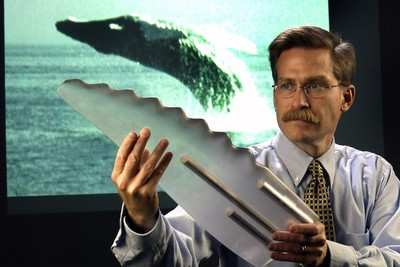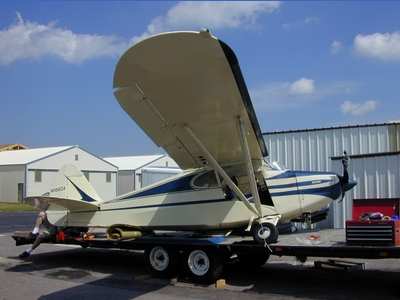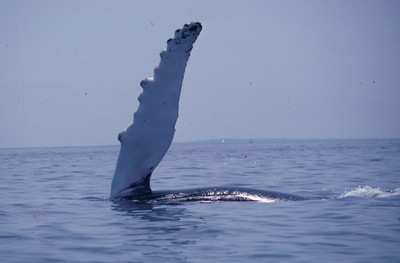Mimicking Humpback Whale Flippers May Improve Airplane Wing
Design
Wind tunnel tests of scale-model humpback whale flippers have
revealed that the scalloped, bumpy flipper is a more efficient wing
design than is currently used by the aeronautics industry on
airplanes. The tests show that bump-ridged flippers do not stall as
quickly and produce more lift and less drag than comparably sized
sleek flippers.

The tests were reported by biomechanicist Frank Fish of West
Chester University, Penn., fluid dynamics engineer Laurens Howle of
the Pratt School of Engineering at Duke University and David
Miklosovic and Mark Murray at the US Naval Academy. They reported
their findings in the May 2004 issue of Physics of Fluids,
published in advance online on March 15, 2004.
In their study, the team first created two approximately
22-inch-tall scale models of humpback pectoral flippers -- one with
the characteristic bumps, called tubercles, and one without. The
models were machined from thick, clear polycarbonate at Duke
University. Testing was conducted in a low speed closed-circuit
wind tunnel at the US Naval Academy in Annapolis (MD).
The sleek flipper performance was similar to a typical airplane
wing. But the tubercle flipper exhibited nearly 8 percent better
lift properties, and withstood stall at a 40 percent steeper wind
angle. The team was particularly surprised to discover that the
flipper with tubercles produced as much as 32 percent lower drag
than the sleek flipper.
"The simultaneous achievement of increased lift and reduced drag
results in an increase in aerodynamic efficiency," Howle
explains.
This new understanding of humpback whale flipper aerodynamics
has implications for airplane wing and underwater vehicle design.
Increased lift (the upward force on an airplane wing) at higher
wind angles affects how easily airplanes take off, and helps pilots
slow down during landing.
Improved resistance to stall would add a new margin of safety to
aircraft flight and also make planes more maneuverable. Drag -- the
rearward force on an airplane wing -- affects how much fuel the
airplane must consume during flight. Stall occurs when the air no
longer flows smoothly over the top of the wing but separates from
the top of the wing before reaching the trailing edge. When an
airplane wing stalls, it dramatically loses lift while incurring an
increase in drag.

As whales move through the water, the tubercles disrupt the line
of pressure against the leading edge of the flippers. The row of
tubercles sheers the flow of water and redirects it into the
scalloped valley between each tubercle, causing swirling vortices
that roll up and over the flipper to actually enhance lift
properties.
"The swirling vortices inject momentum into the flow," said
Howle. "This injection of momentum keeps the flow attached to the
upper surface of the wing and delays stall to higher wind
angles."
"This discovery has potential applications not only to airplane
wings but also on the tips of helicopter rotors, airplane
propellers and ship rudders," said Howle.
The purpose of the tubercles on the leading edge of humpback
whale flippers has been the source of speculation for some time,
said Fish. "The idea they improved flipper aerodynamics was so
counter to our current doctrine of fluid dynamics, no one had ever
analyzed them," he said.
Humpback whales maneuver in the water with surprising agility
for 44-foot animals, particularly when they are hunting for food.
By exhaling air underwater as they turn in a circle, the whales
create a cylindrical wall of bubbles that herd small fish inside.
Then they barrel up through the middle of the "bubble net," mouth
open wide, to scoop up their prey.
According to Fish, the scalloped hammerhead shark is the only
other marine animal with a similar aerodynamic design. The expanded
hammerhead shark head may act like a wing.
The trick now is to figure out how to incorporate the advantage
of the tubercle flipper into manmade designs, said Fish.

The research team now plans to perform a systematic engineering
investigation of the role of scalloped leading edges on lift
increase, drag reduction and stall delay.
 ANN's Daily Aero-Term (05.05.25): Circle To Runway (Runway Number)
ANN's Daily Aero-Term (05.05.25): Circle To Runway (Runway Number) ANN's Daily Aero-Linx (05.05.25)
ANN's Daily Aero-Linx (05.05.25) NTSB Prelim: De Havilland DHC-1
NTSB Prelim: De Havilland DHC-1 Classic Aero-TV: The Boeing Dreamliner -- Historic First Flight Coverage
Classic Aero-TV: The Boeing Dreamliner -- Historic First Flight Coverage Airborne-NextGen 05.06.25: AF Uncrewed Fighters, Drones v Planes, Joby Crew Test
Airborne-NextGen 05.06.25: AF Uncrewed Fighters, Drones v Planes, Joby Crew Test





